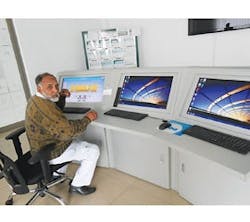Sustainably Meeting Standards
Nestle is one of the world’s largest multinational companies dealing in food items and milk products. The company strives to follow ethical business practices and environmentally friendly operations. Being ISO 14000 certified, Nestle follows environmental standards regarding the treatment of wastewater from its industry.
Nestle Sheikhupura in Pakistan expanded its range of products, requiring the addition of some new process lines in the factory. The old wastewater treatment plant (WWTP) installed 20 years prior was technologically outdated and undersized. The final treated effluent from the WWTP was not meeting the National Environmental Quality Standards (NEQS) of Pakistan. Even the addition of polymers to settle the poor quality sludge in the clarifier was unsuccessful and the effluent’s total suspended solids (TSS) were higher than what the NEQS required. Nestle decided to demolish the existing WWTP and install a fully automatic plant with recycling of treated wastewater to be used in cooling towers, horticulture and road washing.
3W Systems (Pvt.) Ltd. is an engineering company providing solutions in the field of water and wastewater treatment. The company took on the challenge to treat the highly polluted wastewater with chemical oxygen demand (COD) of 4,500 mg/L and biochemical oxygen demand of 2,500 mg/L. 3W Systems was selected for the job after competing against 20 wastewater and effluent treatment companies. The whole project was to be completed within one year, including development of detailed design.
Design objectives were to utilize a minimal footprint, achieve maximum treatment efficiency, produce 25% of the treated effluent at a reusable quality, accommodate future increased flows, and create economical capital and operational costs.
System Components
Civil, electrical, mechanical and instrumentation design was done by 3W Systems. The WWTP included the following components:
- • Dissolved air flotation system for removal of oils and grease;
- • Equalization tank to minimize the hydraulic and organic shock loads with overflow weir mechanism for removal of fats, oils and grease;
- • Oxidation ditch to remove the organic matter through bacterial biodegradation under aerobic conditions;
- • Secondary clarifiers for the sludge settlement and solid liquid separation;
- • Sludge thickeners and belt filter press system for the dewatering of sludge to produce manure; and
- • Tertiary treatment through GE ultrafiltration (UF) Zenon membranes for producing TSS-free reusable water.
The complete process was designed to be used for a period of 20 years.
The WWTP is fully automated and controlled through a SCADA system. This minimizes the operator’s physical presence on the various unit processes, as the whole operation can be performed using a computer. Complete programming of the SCADA system also was done by 3W Systems engineers.
The plant is producing high-quality treated wastewater that is being used for various applications by Nestle’s utility department. Maximum COD of this plant is approximately 15 to 30 mg/L, reduced from 4,500 mg/L.
Installing this WWTP was a step toward sustainability, which led to direct and indirect economical benefits. Direct benefits included pumping the equivalent cost of the reclaimed water and the profits gained from selling dried sludge as manure. The indirect benefits included reduced untreated wastewater discharge and associated costs, reduced risk of environmental penalties, earned carbon credits and increased clientele with environmental certifications. Other economical benefits from 3W’s design were substantial reduction in the cost of acid dosing in the equalization tank, fewer operators being required, elimination of the need for polymer addition in the clarifier and optimized electricity use.
3W Systems completed the job in one year and within the specified budget. The company handed over the WWTP after commissioning it in November 2012. The safety considerations were effective and there were no accidents registered during the project. Overall, this is one of the largest industrial WWTPs installed in Pakistan that not only is meeting NEQS, but also producing treated water that is reused in the cooling tower applications within the same facility.
Download: Here
